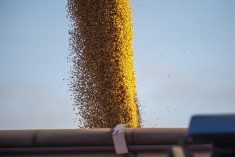By Amanda Cooper and Manolo Serapio Jr
LONDON/SINGAPORE, Aug 11 (Reuters) – Oil, crops, copper and other commodities tumbled on Tuesday after China devalued the yuan, raising concerns that a persistently weaker currency will choke off demand in the world’s top commodities consumer.
China’s central bank made what it called a “one-off depreciation” of nearly two percent in the yuan after a run of poor economic data, which sent the currency to a three-year low.
The prospect of China buying fewer commodities weighed down the Canadian dollar. The Bank of Canada noon rate was down about a half cent against the U.S. dollar.
Read Also

ICE Canada Weekly: Canola poised to slip below C$600/tonne
Look for November canola to slip below C$600 per tonne by the end of Thanksgiving week, said Phil Speiss, trader with RBC Dominion Securities in Winnipeg.
“When you have the biggest customer for oil and commodities devaluing, then obviously you find your product coming under pressure and that is really how the day has panned out,” said Saxo Bank commodities strategist Ole Hansen.
“We’ve see this kind of competitive devaluations (in other currencies) over the last year, which left the (yuan) relatively over valued and they are reacting to that because their economy cannot sustain a strong currency at this stage,” he said.
China’s decision followed weekend data that showed a steep fall in exports and a slide in producer prices to a near six-year low in July. China’s strong yuan policy, partly designed to foster its use as an international currency, has hurt low-end export manufacturers.
The devaluation could be the first shot of a global currency war.
Benchmark Brent crude oil futures fell by 2.3 percent on the day to $49.46 a barrel, having touched a seven-month low of $48.24 on Monday.
Adding to the pressure on crude was a monthly report from the Organization of the Petroleum Exporting Countries (OPEC) in which it said it expected no extra demand for its crude oil this year despite faster global growth in consumption.
Agricultural commodities also came under pressure.
Chicago corn and soybean futures dropped more than 1 percent and wheat fell following the Chinese devaluation and on receding concern about U.S. weather.
FRAGILE CHINA
Concern about a slowing in the Chinese economy has been compounded by a rout in its equity market that has wiped eight percent off the value of blue-chip stocks so far this quarter.
Chinese consumption of oil accounts for more than 10 percent of global demand, while demand for copper equates to between 45 to 50 percent of total consumption for the metal that is the backbone of the electronics industry.
The fear among investors is that China’s decision is not a one off, but rather has the longer-term aim of making its exports more competitive.
“The intention is to encourage exports and the government may figure out several solutions for that, not just the exchange rate,” said Wang Li, a consultant at CRU Group in Beijing.
Credit Suisse said “it would take much bigger action to ease the pain among exporters, but in our view, that is not on the high priority list of the decision makers.”
Spot gold, which tends to benefit from heightened investor uncertainty, rose 0.3 percent to $1,107.36 an ounce.
Gold has been under pressure this year from an impending hike in U.S. interest rates and has struggled to hold above $1,100 since a July 20 rout that pushed it down to $1,077 on July 24, its cheapest since 2010.
But the prospect of an all-out race to the bottom among exporting nations enticed some safe-haven buying.
“Gold is benefiting from fears that this is a new round of ‘currency war’,” Macquarie analyst Matthew Turner














